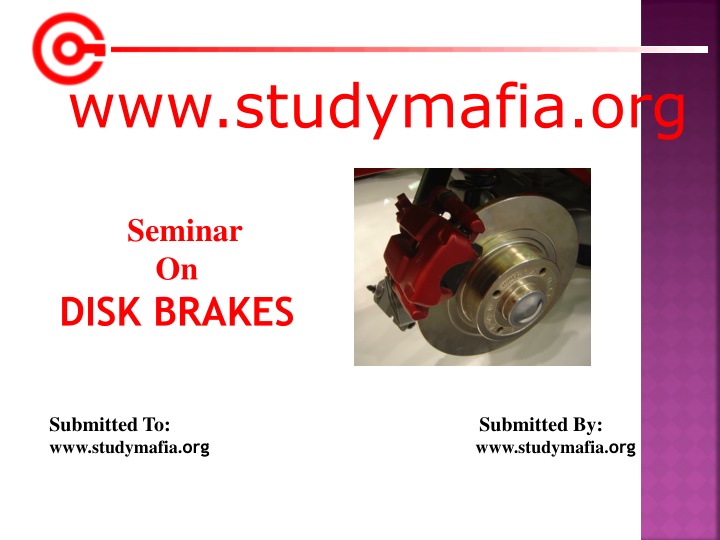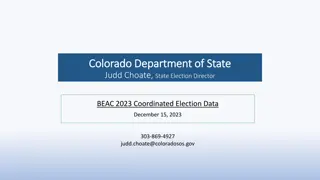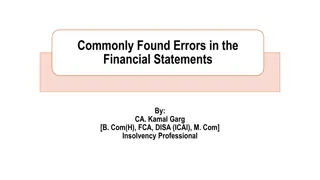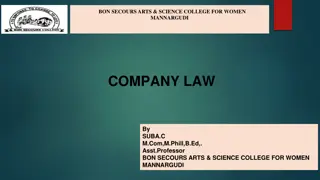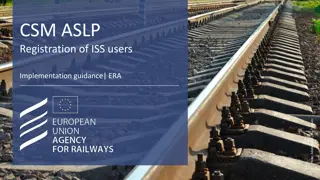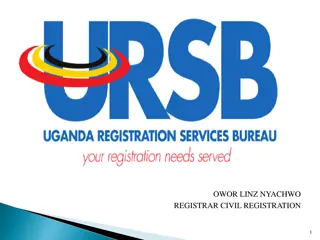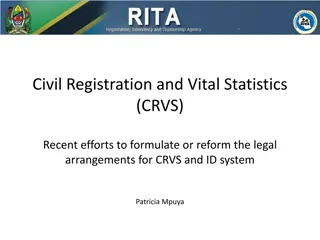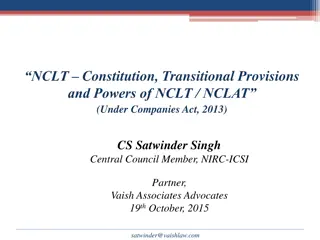Guidelines on Company Name Registration Under Companies Act 2013
The guidelines specify provisions for registering, changing, and rectifying a company name under the Companies Act 2013. It covers conditions, prohibitions, and new provisions for determining undesirable names. Further additions for name registration are also outlined.
Download Presentation

Please find below an Image/Link to download the presentation.
The content on the website is provided AS IS for your information and personal use only. It may not be sold, licensed, or shared on other websites without obtaining consent from the author.If you encounter any issues during the download, it is possible that the publisher has removed the file from their server.
You are allowed to download the files provided on this website for personal or commercial use, subject to the condition that they are used lawfully. All files are the property of their respective owners.
The content on the website is provided AS IS for your information and personal use only. It may not be sold, licensed, or shared on other websites without obtaining consent from the author.
E N D
Presentation Transcript
www.studymafia.org Seminar On DISK BRAKES Submitted To: www.studymafia.org Submitted By: www.studymafia.org
CONTENT Introduction How They Work History Break basics Why Disk Brakes? Why are disk brakes more efficient? Types Advantages Disadvantages Conclusion References
INTRODUCTION Disc brakes are a brake system that slows a wheel s rotation by squeezing an attached metal disc in a viselike hydraulic caliper. Disc brakes use the same principle as bicycle handbrakes, but on a bike the brake pads press against the wheel itself. On a car, the disc is part of the hub to which the wheel is mounted. The disc, technically called a rotor, is clearly visible through spoked wheels.
HISTORY OF DISK BRAKES Ever since the invention of the wheel, if there has been "go" there has been a need for "whoa. As the level of technology of human transportation has increased, the mechanical devices used to slow down and stop vehicles has also become more complex. Before there was a "horse-less carriage," wagons, and other animal drawn vehicles relied on the animal s power to both accelerate and decelerate the vehicle.
BRAKE BASICS Leverage Hydraulics Friction
WHY DISK BRAKES? Why disk brakes in a truck or bus that travels in excess of 65 mph? Improved road handling, higher engine ratings and torque, reduced drag and rolling resistance resulting in faster acceleration and higher average speeds Higher vehicle speeds with full loads Higher traffic density, greater chances of emergency braking Extremely high kinetic energy needed to brake on wet roads, high front axle loads effecting vehicle directional stability
WHY ARE DISK BRAKES MORE EFFICIENT? Flat brake disk (axial brake) under high pressure versus round brake drum (radial brake) during braking Full friction surface of the brake pad on the plane brake disk No loss of brake power due to overheating or partial contact from brake drum parts expansion Disk brakes can withstand higher loads and its efficiency is maintained considerably longer even under the highest stresses
WHY ARE DISK BRAKES MORE ECONOMICAL? Clear economic benefits due to long service life and reduced maintenance downtime Long service life of disks and pads versus drum brakes Shorter service downtime due to quick pad changes Good access for visual brake components checks Maintenance free brake components Optimized installation space in the wheel rim resulting in the largest possible brake disks and pads
WHY DO DISK BRAKES HAVE HIGHER SAFETY RESERVES? Minimal braking effect from high temperatures and extreme driving requirements Minimal heat fading No brake disk distortion from extreme heat due to internal ventilation with directional stability and large power reserve under high stress The decisive safety aspects of the disk brake design are shorter braking distances
DISC BRAKES TYPES This type of brake consists of a disc rotor that is rotating together with the wheel and a stationary brake caliper assembly equipped with brake pads. When pads are forced against the rotor from both sides, friction that is generated converts kinetic energy into heat, which causes the rotor and attached wheel to slow or stop.
OPPOSED PISTON TYPE DISC BRAKES This type of disc brake has pistons on both sides of the brake rotor, and there are no moving parts in the caliper assembly other than the pistons themselves. This type of caliper provides very even pressure distribution between pads and rotor providing better braking performance, especially under severe braking conditions.
FLOATING CALIPER TYPE DISC BRAKE For Passenger Cars Floating caliper type disc brakes have a piston (or pistons) only on the inner side of the rotor. When the brake is engaged, a piston pushes the inner brake pad against the rotor. This generates a reaction force that moves the caliper itself along the slide pin, pushing the outer pad against the rotor to clamp it from both sides and achieve braking action.
FOR COMMERCIAL VEHICLES Disc brakes are used mainly in passenger cars, but due to their stable performance at higher speeds and resistance to brake fade, they are gradually spreading into the commercial vehicle segment, where drum brakes were traditionally chosen for their long lining life.
ADVANTAGES OF DISK BRAKE Disk brake requires less effort (brake torque) to stop the vehicle compare to drum brake. It generates less heat compare to drum brake for the same brake torque. Ease of maintenance as disk brake is outside the wheel rim. It cools down faster compare to drum brake. It is less likely to skid compare to drum brake in wet condition.
DISADVANTAGES OF DISK BRAKE It is expensive compare to drum brake. More skills require to operate disk brake compare to drum brake that s the reason why some people are not comfortable with disk brake. If any air remains in disk brake system, it can cause accident as the brake will not work effectively. Disk brake assembly has more moving parts and much complex than drum brake.
CONCLUSION Many trucks and buses are equipped with air actuated sliding caliper disk brakes. The high contact forces are transmitted mechanically via needle mounted actuating device Depending on size the actuating pressure is transmitted evenly to the brake pads via one or two plungers.
REFERENCES www.google.com www.wikipedia.com www.studymafia.org
